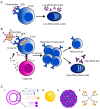Nanoparticles as Delivery Systems for Antigenic Saccharides: From Conjugation Chemistry to Vaccine Design
- PMID: 39591192
- PMCID: PMC11598982
- DOI: 10.3390/vaccines12111290
Nanoparticles as Delivery Systems for Antigenic Saccharides: From Conjugation Chemistry to Vaccine Design
Abstract
Glycoconjugate vaccines have been effective in preventing numerous bacterial infectious diseases and have shown recent potential to treat cancers through active immunotherapy. Soluble polysaccharides elicit short-lasting immune responses and are usually covalently linked to immunogenic carrier proteins to enhance the antigen-specific immune response by stimulating T-cell-dependent mechanisms. Nonetheless, the conjugation of purified polysaccharides to carrier proteins complexifies vaccine production, and immunization with protein glycoconjugates can lead to the undesirable immunogenic interference of the carrier. Recently, the use of nanoparticles and nanoassemblies for the delivery of antigenic saccharides has gathered attention from the scientific community. Nanoparticles can be easily functionalized with a diversity of functionalities, including T-cell epitope, immunomodulator and synthetic saccharides, allowing for the modulation and polarization of the glycoantigen-specific immune response. Notably, the conjugation of glycan to nanoparticles protects the antigens from degradation and enhances their uptake by immune cells. Different types of nanoparticles, such as liposomes assembled from lipids, inorganic nanoparticles, virus-like particles and dendrimers, have been explored for glycovaccine design. The versatility of nanoparticles and their ability to induce robust immune responses make them attractive delivery platforms for antigenic saccharides. The present review aims at summarizing recent advancements in the use of nano-scaled systems for the delivery of synthetic glycoantigens. After briefly presenting the immunological mechanisms required to promote a robust immune response against antigenic saccharides, this review will offer an overview of the current trends in the nanoparticle-based delivery of glycoantigens.
Keywords: antigens; conjugation; glycoconjugates; immune responses; liposomes; nanocarriers; nanoparticles; polysaccharides; vaccines.
Conflict of interest statement
Author Serge Moffet and Tze Chieh Shiao were employed by Glycovax Pharma Inc. The remaining authors declare that the research was conducted in the absence of any commercial or financial relationships that could be construed as a potential conflict of interest. The authors declare that this study received funding from Glycovax Pharma Inc. The funder was not involved in the study design, collection, analysis, interpretation of data, the writing of this article or the decision to submit it for publication.
Figures


Similar articles
-
Generalized Modules for Membrane Antigens as Carrier for Polysaccharides: Impact of Sugar Length, Density, and Attachment Site on the Immune Response Elicited in Animal Models.Front Immunol. 2021 Sep 14;12:719315. doi: 10.3389/fimmu.2021.719315. eCollection 2021. Front Immunol. 2021. PMID: 34594333 Free PMC article.
-
Advancing Homogeneous Antimicrobial Glycoconjugate Vaccines.Acc Chem Res. 2017 May 16;50(5):1270-1279. doi: 10.1021/acs.accounts.7b00106. Epub 2017 May 2. Acc Chem Res. 2017. PMID: 28463499
-
Protein Carriers for Glycoconjugate Vaccines: History, Selection Criteria, Characterization and New Trends.Molecules. 2018 Jun 15;23(6):1451. doi: 10.3390/molecules23061451. Molecules. 2018. PMID: 29914046 Free PMC article. Review.
-
Recent advances on smart glycoconjugate vaccines in infections and cancer.FEBS J. 2022 Jul;289(14):4251-4303. doi: 10.1111/febs.15909. Epub 2021 Jun 1. FEBS J. 2022. PMID: 33934527 Free PMC article. Review.
-
Development of meningococcal polysaccharide conjugate vaccine that can elicit long-lasting and strong cellular immune response with hepatitis B core antigen virus-like particles as a novel carrier protein.Vaccine. 2019 Feb 8;37(7):956-964. doi: 10.1016/j.vaccine.2018.12.073. Epub 2019 Jan 14. Vaccine. 2019. PMID: 30655174
Cited by
-
Nano-Oncologic Vaccine for Boosting Cancer Immunotherapy: The Horizons in Cancer Treatment.Nanomaterials (Basel). 2025 Jan 16;15(2):122. doi: 10.3390/nano15020122. Nanomaterials (Basel). 2025. PMID: 39852737 Free PMC article. Review.
References
Publication types
Grants and funding
LinkOut - more resources
Full Text Sources

